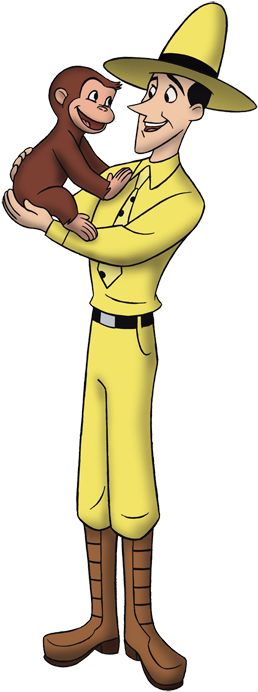Curious George, a charming primate endowed with an insatiable curiosity, embodies the quintessential spirit of adventure, while his counterpart, the Man in the Yellow Hat, serves as a steadfast guardian and companion. Together, they navigate a kaleidoscope of experiences, encapsulating the intricacies of friendship, mischief, and the philosophical underpinnings of cultural relativism. The dynamic duo represents not only a bond filled with levity and spontaneity but also a rich tapestry of lessons applicable to the broader cultural context in which they exist.
The relationship between Curious George and the Man in the Yellow Hat is emblematic of companionship transcending species boundaries. Here, the metaphor of the “yellow hat” serves as a beacon of guidance, illuminating George’s whimsical forays into the world around him. This hat symbolizes not only protection but also the open-mindedness required to nurture a relationship where growth, learning, and mischief can flourish. It is a salient reminder that curiosity—often viewed as a potential source of chaos—can be the key to understanding the world through diverse perspectives.
At the heart of their escapades lies the theme of mischief. Curious George’s antics, ranging from the benign to the considerably more disruptive, serve to challenge societal norms and conventions. Each of his capers, while seemingly harmless, invites viewers to explore the implications of his actions within a broader cultural context. When George discovers a new facet of human life, whether it be an alluring toy or a perplexing contraption, he embodies the ethos of an untamed spirit observing the strictures of an ordered society. The Man in the Yellow Hat, in his unwavering patience, represents the societal systems that strive to contain such unbridled curiosity while simultaneously allowing it to flourish.
Importantly, the interactions between the two characters encapsulate a pedagogical component, wherein the mischief serves as a conduit for valuable life lessons. George’s forays often culminate in unforeseen consequences, prompting both self-reflection and growth. The narrative invites audiences to ponder how reactions to mischief can vary significantly across cultural paradigms. The Man in the Yellow Hat’s responses—be it laughter, exasperation, or gentle reprimand—highlight the notions of discipline and understanding that can differ across cultures. Thus, what may be viewed as misbehavior in one culture might be perceived as playful exploration in another, shedding light on the foundational principles of cultural relativism.
Moving beyond the individualistic lens, the relationship between George and the Man in the Yellow Hat illustrates broader societal dynamics. Their interactions serve as microcosms of cooperation and conflict found in human relationships. The juxtaposition of George’s exuberance against the Man’s responsible demeanor emphasizes the delicate balance of freedom and control within societal structures. This balance is echoed in the concept of cultural relativism, which posits that beliefs and values must be understood within their cultural context. Therefore, George’s innocent yet defiant spirit encourages a reconsideration of established norms, pushing both characters—and by extension the audience—to engage critically with the way we perceive mischief and authority.
The narrative encapsulates themes of growth, not just in the characters but within the audience as well. By engaging with Curious George’s perspective, viewers are impelled to explore the expansiveness of curiosity and the beauty of learning from one’s mistakes. Much like the scientific process, which thrives on inquiry and experimentation, the relationship between George and the Man in the Yellow Hat invites deeper introspection into how learning is often a messy, nonlinear process. As George sidesteps conventions, he inadvertently fosters an environment where both his own views and those of the Man in the Yellow Hat are subject to evolution. This dual growth reinforces the significance of flexibility in understanding differing cultural outlooks.
In exploring their bond, it becomes evident that themes of empathetic understanding resonate throughout their interactions. The Man in the Yellow Hat exhibits a remarkable ability to empathize with George, recognizing that the primate’s mischief is not born of malice but rather an expression of unquenchable curiosity. This response underscores the notion that friendship, even in its most tumultuous manifestations, can thrive on mutual understanding and acceptance. The Man’s willingness to adapt to George’s whims exemplifies the collaborative nature of cross-cultural dialogues, where listening and compassion pave the way for enriched relationships.
Ultimately, the adventures of Curious George and the Man in the Yellow Hat extend far beyond mere entertainment; they encapsulate existential inquiries into the nature of curiosity, companionship, and cultural understanding. Their escapades provide nuanced commentary on the significance of embracing perspectives different from our own. By recognizing that mischief can be both playful and educational, we gain deeper insights into friendship that transcends species and societal norms. In a world rife with complexities, Curious George’s journey reminds us that curiosity, when paired with thoughtful companionship, can lead to profound understanding and a celebration of our interconnectedness.
The story of Curious George and the Man in the Yellow Hat thus stands as a testament to the beauty of friendship grounded in mischief and the exploration of cultural relativism. Their narrative beckons one to engage in the wider dimensions of existence, prompting a reevaluation of how we navigate our relationships within a diverse world. As they embark on their whimsical journeys, they invite us to consider how we might foster a spirit of curiosity and understanding in our own lives.
